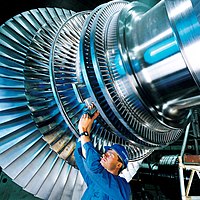
Photo from wikipedia
This paper investigates spontaneous condensation of wet steam in a centrifugal turbine by means of three-dimensional computational fluid dynamics. The flow field and aerodynamic characteristics of the wet steam in… Click to show full abstract
This paper investigates spontaneous condensation of wet steam in a centrifugal turbine by means of three-dimensional computational fluid dynamics. The flow field and aerodynamic characteristics of the wet steam in the centrifugal turbine are compared and analyzed by using the equilibrium steam and nonequilibrium steam models, respectively, where the latter applies the classical droplet nucleation theory and neglects velocity slip between the liquid phase and the gaseous phase. The state parameters of wet steam are described here based on the IAPWS’97 formulation. It is concluded that under the design condition, the mass flow rate, wetness fraction, and flow angle of the wet steam centrifugal turbine in the nonequilibrium steam model all change compared with the equilibrium steam model, with values of 4.4%, 0.5%, and 10.57%, respectively. Then the performance variation of the wet steam centrifugal turbine is analyzed under different steam conditions and different outlet back-pressure conditions. The results show that the change law of the mass flow rate, shaft power, and wetness fraction in the centrifugal turbine are basically identical in both models, and the mass flow rate, shaft power, wheel efficiency, and entropy loss coefficient of the centrifugal turbine in the nonequilibrium steam model are all higher than those in the equilibrium steam model, whereas the outlet wetness fraction is lower than that in the equilibrium steam model.
Journal Title: Proceedings of the Institution of Mechanical Engineers, Part A: Journal of Power and Energy
Year Published: 2019
Link to full text (if available)
Share on Social Media: Sign Up to like & get
recommendations!